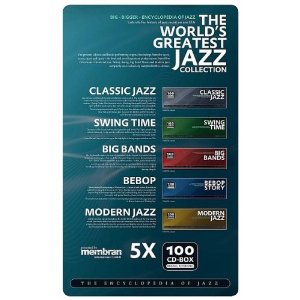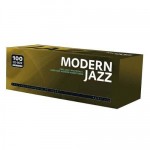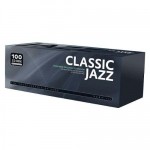Wondering what to do with your Christmas bonus or cash gifts? I know how you can get a 500-disc series of jazz recordings for about $500.
This series, entitled “The Encylopedia of Jazz,” is probably the largest-scale recording project ever put together. Experts and collector friends I consulted couldn’t come up with anything in the past larger than the Philips “Great Pianists of the 20th Century,” 100 two-disc sets.
“The Encylopedia of Jazz” is published by Membran, a huge German conglomerate which has issued many super-bargain sets in the past. I own quite a few of its “Quadromania” boxes, four disc sets which I bought for an average of about $12. They include fine selections, mostly of jazz musicians but sometimes classical music, in quite good sound, with good documentation and even rudimentary program notes. Membran also has issued many 10-disc sets, economically packaged in small boxes with the individual discs in strong paper sleeves. These sets come with no documentation at all, just names of performers and titles. I have a wonderful Ella Fitzgerald set in this series, and a box of tango recordings most of which come from 78s. They’re delightful. I had the Miles Davis set also, but I gave it away because I was so frustrated in being unable to find out who was playing on each individual track. (Also, apparently to get around copyright laws dealing with compilations, Davis’s LPs were broken up between different CDs, making for a frustrating listening experience.)
“The Encylopedia of Jazz” was issued in 2008. This leaves me fearful that it could disappear before too long. Membran once had a 168-disc set of ragtime and early jazz, which I frequently saw on eBay. I was determined to get a copy for $100 or less, but I kept being outbid by a few dollars and never got one. Now it’s apparently out of print and being offered for $700. So, when I ran into the new series by accident on eBay, I bought the first volume, “Classic Jazz,” to check it out. The selection and sound quality were good enough so that I quickly picked up the remaining four volumes. Didn’t want them to get away.
I can’t review this series. I’m only halfway through listening to Volume 1, and some of that “listening” has been pretty casual. But I can give you a description and overview of the series.
Each boxed set has 100 CDs. The paper sleeves that hold the discs list the titles, authors, and timings. A booklet with each set has personnel listings and matrix numbers (but not labels or issue numbers). There are no program notes, but every once in a while the compiler has sneaked in a comment (like identifying Louis Armstrong’s first recorded vocal). Each set also comes with a CD-ROM listing the contents of the entire series. Many of the discs are encoded with text information which tells you the name of the set, the disc number, the title of the disc (usually the leader of the group), and the track title. This information is really useful when you’re driving. However, some discs in the first two sets (all I have investigated) lack this encoding, and a few apparently list only the track number, not its title.
Nearly all the discs are devoted to one performer or band, but in the cases of the few compilations the names of the performers are not in the texts. One of the most useful discs in “Classic Jazz” is a collection of very early recordings from New Orleans, all of which are fascinating and most of which are by performers I’ve never heard of. (They must have been recorded by mobile recording units, since there was no recording studio in New Orleans until Cosimo Metassa started his after World War II!) If you’re listening to this disc in the car, you can’t find out who is performing on each track without taking your life in your hands to look at the disc sleeve.
I know one dealer who refused to sell these sets, after they were offered to him at very low prices, because of the hazards of dealing with large sets. Here’s one example: in “Classic Jazz,” disc 58 is supposed to contain recordings by Eddie Lang and Joe Venuti. It’s properly labeled and comes in the right sleeve, but the contents of the disc is actually identical to that of disc 69, a Bix Beiderbecke collection (which also appears properly on disc 69). I wrote to Membran asking for a replacement disc but got no answer, so the error was probably never corrected. I can only imagine what this dealer would have gone through getting back the whole set because of this error and being unable to do anything about it. Also, unless you put the box in your listening room and the discs never get far from their box, there’s an excellent chance that a disc or two will stray and be missing for a while or forever. My own “Classic Jazz” disc 11 has gone missing and I’m still looking for it.
Another drawback: while these boxes aren’t gigantic for 100-disc sets, they aren’t as economical as they could have been. Instead of lining all the discs up in a row, they are presented in three mini-browsers, each allowing enough room to flip through the discs. This format makes it easy to locate a given disc, but it also means each one of the boxes take up lots more space than Brilliant Classics’ 170-disc set of the complete Mozart.
There are two peculiarities of the Encyclopedia of Jazz which may affect some potential listeners one way or the other. The first is the inclusion of alternate takes. There are many of them. The disc of the earliest Duke Ellington even has a couple that were not in the Classics label’s coverage of the same period. When I get to hear alternate takes of great soloists like Louis Armstrong or Charlie Parker, I can definitely enjoy their different responses to the same tune. But the great majority of these alternate takes don’t feature outstanding improvisors, and I find hearing almost identical versions of the same arrangement two or three times unilluminating. Also, strangely, the producers of these sets allow very little time between tracks. The industry standard is usually 5 or 6 seconds. On these discs, it’s about a second. I’ve gotten used to this but it’s still not my preference.
When I first saw the listings of these sets, I was skeptical about the sound quality. When I started listening to them, I became skeptical about their origins instead. While they aren’t the absolute ultimate in transfer work–the early King Oliver sides, for example, aren’t quite as vivid as they are in the Off the Record/Archeophone set–they are mighty damn close. I spent some time trying to figure out what label or labels Membran had gotten its material from. But several factors, including credits to collectors in the booklets coming with the later sets, have left me fairly certain that Membran has done its own transfers. How the label managed to compile this amazing collection of material–approximately 10,000 sides!–I will never understand. But it does seem that the series has been compiled and transferred from scratch. (Sorry!)
Glancing through the contents of all five sets, I am fairly impressed with the quality of the selections. The “Big Band” set was the most pleasant surprise. I was afraid it would be full of non-jazz blandness like Glenn Miller, but there’s only one Miller disc, and lots of Fletcher Henderson, Duke Ellington, and Count Basie. Some of the “Classic Jazz” discs might seem like wastes of time, and my real introduction to “Red” Nichols demonstrated why my friend Tom Piazza’s “Guide to Classic Recorded Jazz” dismisses him as “much-recorded” with no further discussion. But the Goofus Five gets two discs, 25 tracks each, and while they’re not great music they are very entertaining, perfect driving music.
There is one very major drawback to the selections. The series should have been titled, “Encyclopedia of Instrumental Jazz.” Singers appear only incidentally, if they performed with bands that are otherwise included. There are no discs devoted to Ella Fitzgerald (as I mentioned above, Membran has already issued a ten-disc set of her, so they had the material), Billie Holiday, Sarah Vaughan, or any other singers. So what did I want, a sixth set of great singers? Maybe. Also, the compilers have gone out of their way to avoid piano solos. There’s a group of Earl Hines solos on one of his discs, but the early Jelly Roll Morton collections leave out his fabulous 1923-24 solo sides completely. I haven’t noticed any solos by Fats Waller or James P. Johnson either.
While none of these sets offers comprehensive coverage of its topic, most of them are pretty thorough. I can’t think of a major artist who is omitted, although no doubt a real jazz expert could. The “Modern Jazz” set is more of a sampler than the others, including relatively small selections of some major artists. (The one disc devoted to Monk presents his album with Art Blakey and the Jazz Messengers, one of the least characteristic of his recordings and one of my least favorite.)
So, accepting all these shortcomings, do you still want to fill up about seven feet of shelf space with these boxes? I expect them to be keeping me company for the rest of my life, and I’m sure that although I’ll play through every disc in the years to come, I’ll never have enough time to absorb all the material. I’m still glad I have them. So I’m going to tell you how I recommend buying them. But let me add that you might want to keep an eye on eBay’s auction listings. As I write, used copies of all five boxes are on offer, and the high bid on each is $75, but they have only a few hours to run and will be gone by the time this posts. Still, they could show up again. For more reliable purchases, a combination of Amazon and eBay will serve you best:
Classic Jazz: available through Amazon for $81.31 (prices listed include shipping).
Big Bands: available through Amazon for $80.00
Swing Time: available through eBay for $149.99 “or best offer.” Also available new or used from amazon
Bebop Story: available through Amazon for $80.33.
Modern Jazz: available through eBay for $199.99 “or best offer,” Amazon for $165.74.
I don’t know why the “Modern Jazz” set is offered at so much higher a price. However, I tried making “best offers” on the sets I bought (from a seller in Germany, who charges no additional shipping). I got “Swing Time” for $120, “Modern Jazz” for $125. My total outlay for the entire series was just a bit over $500.

The entire set is available from amazon, under the title “The World’s Greatest Jazz Collection”



April 27th, 2012 at 8:50 am
I don’t suppose the CDRoms include a tracklisting that you could post here do they?
April 30th, 2012 at 5:18 pm
Sorry, not practical to post a listing of 10,000 items, not to mention potential problems in unauthorized use of copyrighted material. That’s ironic, since the contents of the 500 discs are all public domain material, but the listing isn’t. LG
January 2nd, 2013 at 5:09 pm
Full Contents:
1/5 CLASSIC JAZZ: From New Orleans to Harlem
http://www.jpc.de/include/pdf/6924548.pdf
2/5 SWING TIME: ALL-STAR SWING GROUPS WITH THEIR MOST FAMOUS RECORDINGS
http://www.jpc.de/include/pdf/6924549.pdf
3/5 BIG BANDS: THE GIANTS OF THE SWING BIG BAND ERA
http://www.jpc.de/include/pdf/6924550.pdf
4/5 BEBOP STORY: A musical Revolution that radically changed the Road of Jazz
http://www.jpc.de/include/pdf/6924551.pdf
5/5 MODERN JAZZ: Cool Jazz, Westcoast, Hard-Bop, Modern Mainstream
http://www.jpc.de/include/pdf/6924552.pdf
January 11th, 2013 at 1:18 pm
Thanks. Very useful.
January 2nd, 2013 at 5:10 pm
My Swing Time collection has twice CD 054 but no CD 053.
Have yours the same issue?
Than you.
January 11th, 2013 at 1:17 pm
My copy does not have the same issue. I have both CDs 53 and 54. You might have some luck contacting the manufacturer for the missing disc.